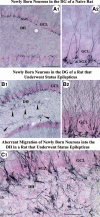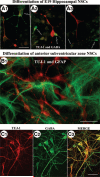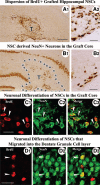Concise review: prospects of stem cell therapy for temporal lobe epilepsy
- PMID: 17600108
- PMCID: PMC3612506
- DOI: 10.1634/stemcells.2007-0313
Concise review: prospects of stem cell therapy for temporal lobe epilepsy
Abstract
Certain regions of the adult brain have the ability for partial self-repair after injury through production of new neurons via activation of neural stem/progenitor cells (NSCs). Nonetheless, there is no evidence yet for pervasive spontaneous replacement of dead neurons by newly formed neurons leading to functional recovery in the injured brain. Consequently, there is enormous interest for stimulating endogenous NSCs in the brain to produce new neurons or for grafting of NSCs isolated and expanded from different brain regions or embryonic stem cells into the injured brain. Temporal lobe epilepsy (TLE), characterized by hyperexcitability in the hippocampus and spontaneous seizures, is a possible clinical target for stem cell-based therapies. This is because these approaches have the potential to curb epileptogenesis and prevent chronic epilepsy development and learning and memory dysfunction after hippocampal damage related to status epilepticus or head injury. Grafting of NSCs may also be useful for restraining seizures during chronic epilepsy. The aim of this review is to evaluate current knowledge and outlook pertaining to stem cell-based therapies for TLE. The first section discusses the behavior of endogenous hippocampal NSCs in human TLE and animal models of TLE and evaluates the role of hippocampal neurogenesis in the pathophysiology and treatment of TLE. The second segment considers the prospects for preventing or suppressing seizures in TLE using exogenously applied stem cells. The final part analyzes problems that remain to be resolved before initiating clinical application of stem cell-based therapies for TLE. Disclosure of potential conflicts of interest is found at the end of this article.
Figures





Similar articles
-
Embryonic stem cell-derived neural precursor grafts for treatment of temporal lobe epilepsy.Neurotherapeutics. 2009 Apr;6(2):263-77. doi: 10.1016/j.nurt.2009.01.011. Neurotherapeutics. 2009. PMID: 19332319 Free PMC article. Review.
-
Neural Stem Cell or Human Induced Pluripotent Stem Cell-Derived GABA-ergic Progenitor Cell Grafting in an Animal Model of Chronic Temporal Lobe Epilepsy.Curr Protoc Stem Cell Biol. 2016 Aug 17;38:2D.7.1-2D.7.47. doi: 10.1002/cpsc.9. Curr Protoc Stem Cell Biol. 2016. PMID: 27532817 Free PMC article.
-
Medial ganglionic eminence-derived neural stem cell grafts ease spontaneous seizures and restore GDNF expression in a rat model of chronic temporal lobe epilepsy.Stem Cells. 2010 Jul;28(7):1153-64. doi: 10.1002/stem.446. Stem Cells. 2010. PMID: 20506409 Free PMC article.
-
Implications of decreased hippocampal neurogenesis in chronic temporal lobe epilepsy.Epilepsia. 2008 Jun;49 Suppl 5(0 5):26-41. doi: 10.1111/j.1528-1167.2008.01635.x. Epilepsia. 2008. PMID: 18522598 Free PMC article. Review.
-
Behavioral and histological assessment of the effect of intermittent feeding in the pilocarpine model of temporal lobe epilepsy.Epilepsy Res. 2009 Sep;86(1):54-65. doi: 10.1016/j.eplepsyres.2009.05.003. Epub 2009 Jun 7. Epilepsy Res. 2009. PMID: 19505798
Cited by
-
The effects of cell therapy on seizures in animal models of epilepsy: protocol for systematic review and meta-analysis of preclinical studies.Syst Rev. 2019 Nov 1;8(1):255. doi: 10.1186/s13643-019-1169-3. Syst Rev. 2019. PMID: 31675988 Free PMC article.
-
GABAergic neuronal precursor grafting: implications in brain regeneration and plasticity.Neural Plast. 2011;2011:384216. doi: 10.1155/2011/384216. Epub 2011 Jun 20. Neural Plast. 2011. PMID: 21766042 Free PMC article. Review.
-
Antiepileptic effects of silk-polymer based adenosine release in kindled rats.Exp Neurol. 2009 Sep;219(1):126-35. doi: 10.1016/j.expneurol.2009.05.018. Epub 2009 May 19. Exp Neurol. 2009. PMID: 19460372 Free PMC article.
-
Stem cells as a potential therapy for epilepsy.Exp Neurol. 2013 Jun;244:59-66. doi: 10.1016/j.expneurol.2012.01.004. Epub 2012 Jan 13. Exp Neurol. 2013. PMID: 22265818 Free PMC article. Review.
-
Embryonic stem cell-derived neural precursor grafts for treatment of temporal lobe epilepsy.Neurotherapeutics. 2009 Apr;6(2):263-77. doi: 10.1016/j.nurt.2009.01.011. Neurotherapeutics. 2009. PMID: 19332319 Free PMC article. Review.
References
-
- Engel J, Jr., Wilson C, Bragin A. Advances in understanding the process of epileptogenesis based on patient material: What can the patient tell us? Epilepsia. 2003;44(suppl 12):60–71. - PubMed
-
- French JA, Williamson PD, Thadani VM, et al. Characteristics of medial temporal lobe epilepsy: I. Results of history and physical examination. Ann Neurol. 1993;34:774–780. - PubMed
-
- Engel J., Jr Etiology as a risk factor for medically refractory epilepsy: A case for early surgical intervention. Neurology. 1998;51:1243–1244. - PubMed
-
- Mathern GW, Adelson PD, Cahan LD, et al. Hippocampal neuron damage in human epilepsy: Meyer's hypothesis revisited. Prog Brain Res. 2002;135:237–251. - PubMed
-
- Mathern GW, Babb TL, Mischel PS, et al. Childhood generalized and mesial temporal epilepsies demonstrate different amounts and patterns of hippocampal neuron loss and mossy fibre synaptic reorganization. Brain. 1996;119:965–987. - PubMed
Publication types
MeSH terms
Substances
Grants and funding
LinkOut - more resources
Full Text Sources
Other Literature Sources

